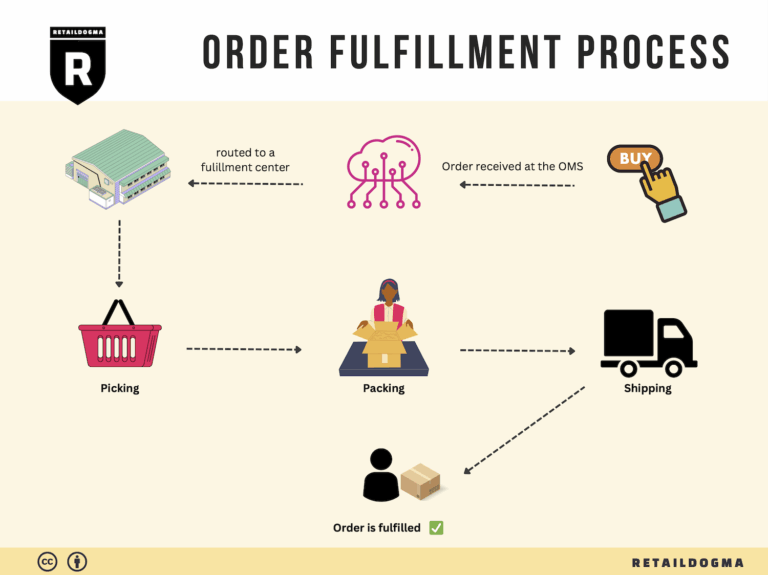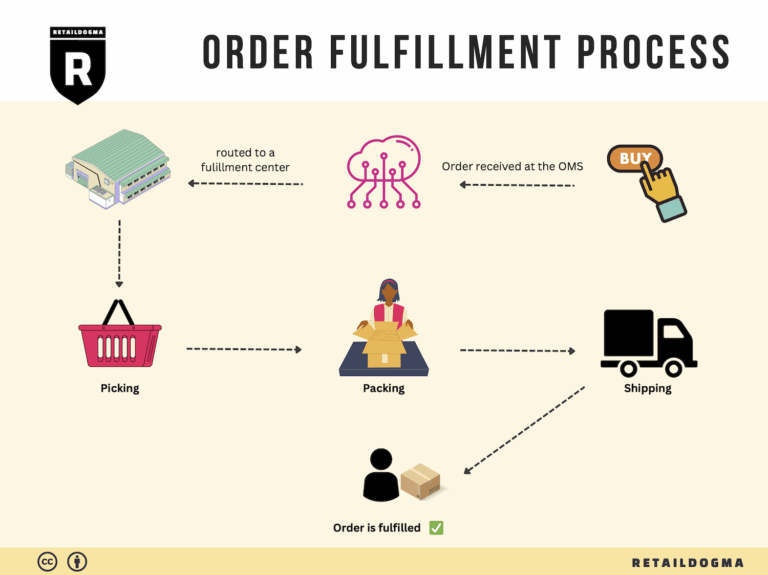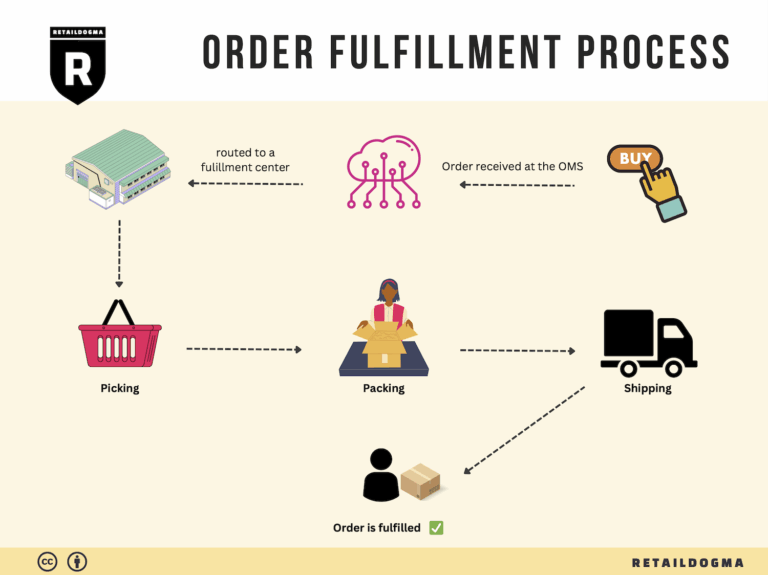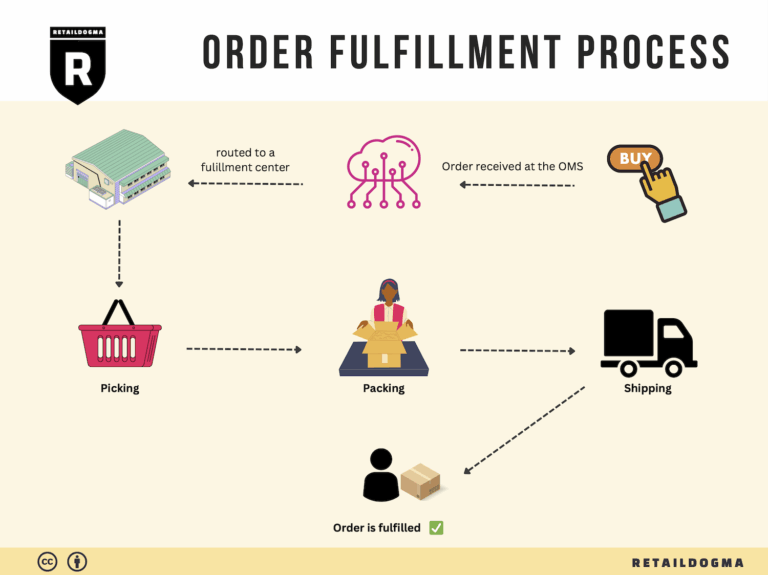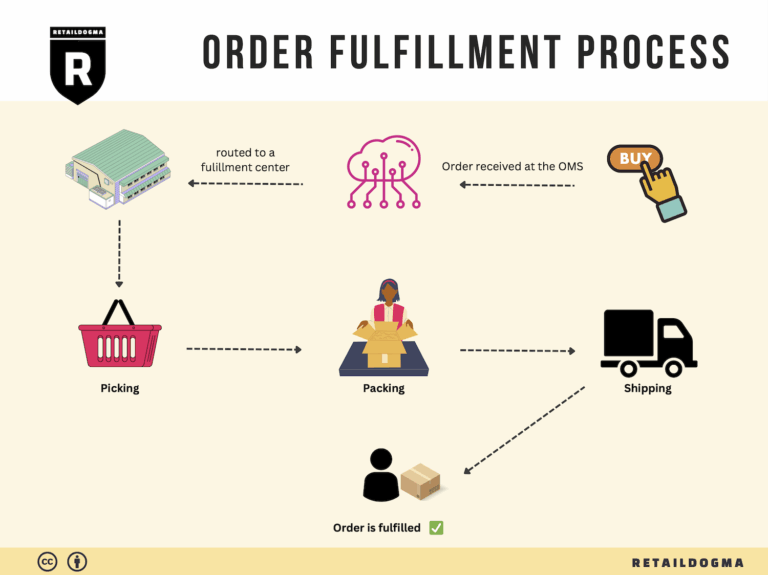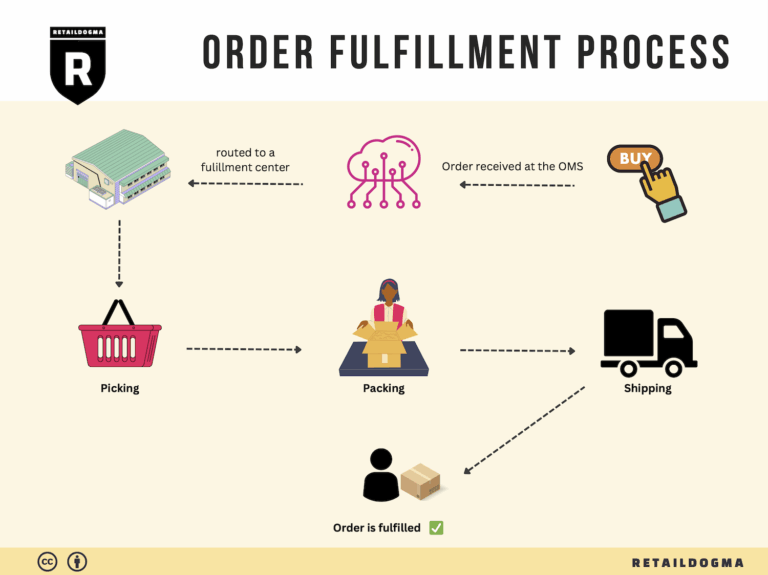What Is A Fulfillment Center? A Complete Guide (2025)
What is E-commerce Fulfillment? An Introduction for Growing Businesses
As an e-commerce business owner, you may find yourself grappling with a common challenge: the overwhelming task of packing and shipping orders. This burden can become particularly daunting as your sales grow and your customer base expands. The fulfillment process—the method of getting your product from your warehouse to your customer’s doorstep—plays a crucial role in your business’s success. Efficient fulfillment not only enhances customer satisfaction but also allows you to focus on scaling your operations.
Understanding Fulfillment
E-commerce fulfillment encompasses the entire lifecycle of an order, from receiving inventory to processing orders, picking and packing items, and finally shipping them to customers. It’s a vital component of your supply chain that directly impacts your customer experience. As your business grows, understanding the various fulfillment models available can help you streamline operations and minimize stress.
In this guide, we will explore different fulfillment models, including Third-Party Logistics (3PL) and Fulfillment by Amazon (FBA). Each model has its unique advantages and is suited to different business needs. For instance, while FBA offers the convenience of leveraging Amazon’s vast logistics network, 3PL providers can offer more personalized services tailored to your specific requirements.
Core Services of Fulfillment
We will also delve into the core services typically offered by fulfillment partners, which include inventory management, order processing, packing, and shipping. Understanding these services is crucial for determining which partner aligns best with your operational goals and customer expectations.
Choosing the Right Partner
Selecting the right fulfillment partner can significantly influence your business’s efficiency and scalability. We will guide you through the key factors to consider when choosing a partner, such as location, technology integration, customer service, and scalability options.
Pricing Considerations
Additionally, pricing is a critical aspect of fulfillment that can impact your bottom line. We will break down the various costs associated with different fulfillment models, helping you to make informed financial decisions.
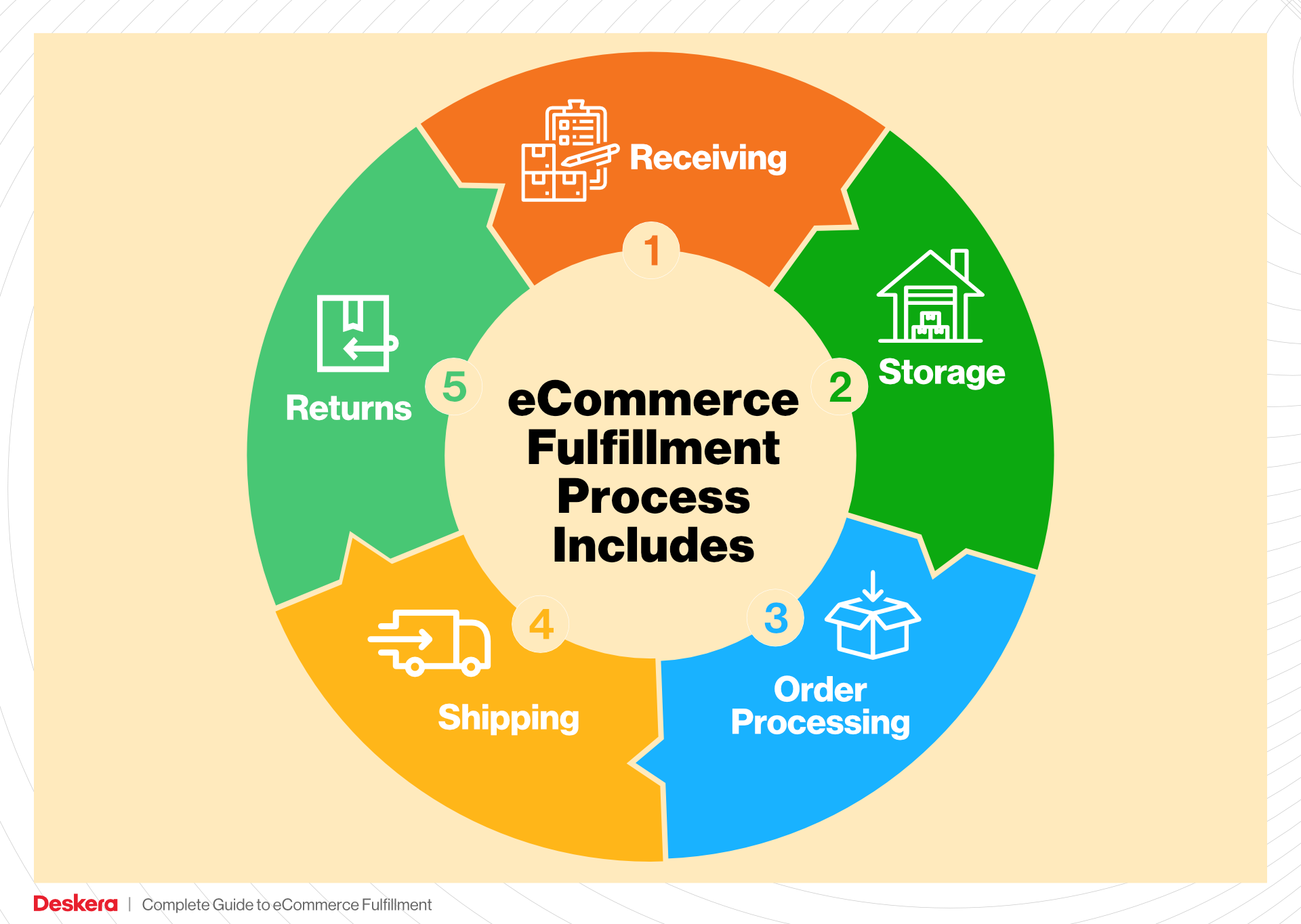
Empowering Your Business
Ultimately, the goal of this guide is to empower you to make smart decisions about your logistics. By understanding the complexities of e-commerce fulfillment, you can enhance your operational efficiency, reduce overhead costs, and improve customer satisfaction. Whether you’re a startup or an established business looking to optimize your fulfillment processes, this guide will provide the insights you need to thrive in the competitive e-commerce landscape.
What You’ll Learn In This Guide
- What is E-commerce Fulfillment? An Introduction for Growing Businesses
- The Order Fulfillment Process: From ‘Buy’ Button to Customer’s Door
- Comparing Fulfillment Models: In-House vs. 3PL vs. Dropshipping
- A Deep Dive into Amazon FBA: Pros, Cons, and Who It’s For
- Core Services Offered by Fulfillment Centers
- How to Choose a Fulfillment Partner: A 6-Point Checklist
- Understanding Fulfillment Pricing: A Breakdown of Common Fees
- Frequently Asked Questions (FAQs) about Fulfillment
- Conclusion: Is Outsourcing Fulfillment the Right Move for Your Business?
- Important Disclaimer
The Order Fulfillment Process: From ‘Buy’ Button to Customer’s Door
1. Receiving Inventory
The order fulfillment process begins with receiving inventory at the fulfillment center. This step is crucial as it sets the foundation for all subsequent operations. When products arrive, they must be checked for quality and accuracy against purchase orders. This involves verifying quantities, inspecting for damages, and ensuring the correct items have been received.
Importance: Proper receiving processes help maintain inventory accuracy and prevent stock discrepancies, which can lead to stockouts or overstock situations. Errors at this stage can cascade through the fulfillment process, leading to customer dissatisfaction.
Key Term: SKU (Stock Keeping Unit) – Each product is assigned a unique SKU, which helps in tracking inventory levels and managing stock efficiently.
2. Warehouse Storage
Once inventory is received and verified, it is then sorted and stored in designated locations within the warehouse. The layout of the warehouse plays a significant role in optimizing storage; products should be organized logically, often by category, size, or demand frequency. This organization facilitates quicker access during the picking process.
Importance: Efficient storage solutions minimize the time spent locating items and reduce the likelihood of errors when fulfilling orders. A well-organized warehouse ensures that inventory is easily accessible, ultimately speeding up the entire fulfillment process.
Key Term: FIFO (First In, First Out) – This inventory management method ensures that older stock is sold before newer stock, minimizing the risk of obsolescence and spoilage, especially for perishable goods.
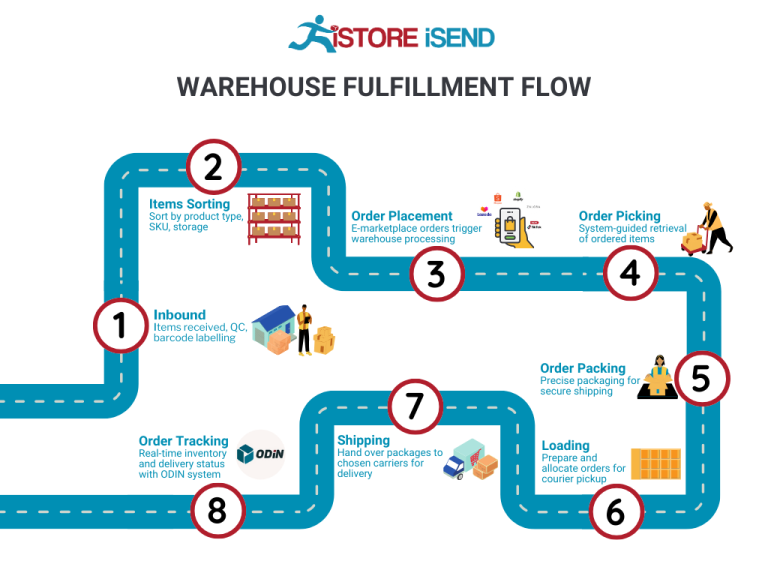
3. Order Picking
When a customer places an order, the fulfillment center initiates the picking process. Staff or automated systems retrieve the items from their storage locations based on the order details. This step can utilize various picking methods, such as single order picking, batch picking, or zone picking, depending on the volume and nature of orders.
Importance: The picking process is critical as it directly impacts order accuracy and speed. Efficient picking methods can significantly reduce the time it takes to fulfill an order, enhancing customer satisfaction and retention.
Key Term: Pick List – A document or digital tool that outlines the items to be retrieved for each order. It helps streamline the picking process and ensures that all items are collected accurately.
4. Order Packing
After items are picked, they must be packed for shipment. Packing involves placing the items into appropriate shipping containers, ensuring they are secure to prevent damage during transit. This step also includes labeling packages with shipping information and often involves including packing slips or invoices.
Importance: Effective packing protects products and minimizes returns due to damage. Additionally, well-packed orders contribute to a positive unboxing experience for customers, which can enhance brand loyalty and encourage repeat purchases.
Key Term: Packing Slip – A document included with the shipment that lists the items in the package. It serves as a receipt for the customer and helps verify that the correct items were sent.
5. Shipping & Delivery
The final step in the order fulfillment process is shipping and delivery. Once packed, orders are handed over to shipping carriers, who transport the products to the customer’s address. This step involves selecting the appropriate shipping method based on factors like cost, speed, and destination.
Importance: Timely and reliable delivery is paramount in e-commerce. A positive delivery experience can significantly enhance customer satisfaction and lead to repeat business. Conversely, delays or issues with delivery can harm a brand’s reputation.
Key Term: Last Mile Delivery – This refers to the final step of the shipping process, where the package is delivered from the distribution center to the final customer. Efficient last mile delivery strategies are crucial for ensuring timely deliveries and improving customer experiences.
Conclusion
Understanding each step of the order fulfillment process is essential for e-commerce businesses aiming to scale effectively. By optimizing these steps—from receiving inventory to shipping and delivery—businesses can enhance efficiency, reduce costs, and ultimately provide a better experience for their customers. Implementing best practices in each stage will contribute to a streamlined operation that meets customer expectations and fosters business growth.
Comparing Fulfillment Models: In-House vs. 3PL vs. Dropshipping
Fulfillment Model Comparison
| Model | Who Handles Inventory | Best For (Business Stage) | Key Advantage | Key Disadvantage |
|---|---|---|---|---|
| In-House Fulfillment | Business (own warehouse) | Established businesses | Complete control over inventory and process | High overhead costs and operational complexity |
| Third-Party Logistics (3PL) | Third-party provider | Growing businesses | Cost-effective scalability and expertise | Less control over inventory and fulfillment process |
| Dropshipping | Supplier | Startups and small businesses | Low overhead and risk | Lower profit margins and reliance on suppliers |
In-House Fulfillment
In-house fulfillment refers to when a business manages its own inventory and logistics operations within its own facilities. This model is typically favored by established businesses that have the resources and demand to justify the investment in warehousing, staffing, and technology. The primary advantage of in-house fulfillment is the complete control it provides over inventory management, order processing, and shipping. Businesses can tailor their processes to meet specific customer needs, ensure quality control, and maintain direct oversight of their supply chain operations. However, the key disadvantage is the high overhead costs associated with maintaining a warehouse, hiring staff, and managing logistics. This model also adds operational complexity, as businesses must invest in technology and systems to efficiently manage inventory and fulfill orders.
Third-Party Logistics (3PL)
Third-party logistics (3PL) involves outsourcing logistics operations to a specialized provider that manages inventory, warehousing, and shipping on behalf of a business. This model is particularly well-suited for growing businesses that need to scale quickly without the burden of managing logistics themselves. The primary advantage of using a 3PL is cost-effective scalability. Businesses can leverage the expertise and infrastructure of a logistics provider, which often includes advanced technology and established shipping networks. This allows businesses to focus on core competencies such as marketing and product development. However, a significant downside is the reduced control over the inventory and fulfillment process. Businesses must rely on their 3PL partners to maintain service levels and accuracy, which can lead to challenges if the provider does not meet expectations.
Dropshipping
Dropshipping is a fulfillment model where the retailer does not hold inventory but instead transfers customer orders directly to a supplier, who then ships the products to the customer. This model is particularly appealing for startups and small businesses that want to minimize upfront investment and risk. One of the main advantages of dropshipping is the low overhead costs, as there is no need to invest in inventory or warehousing. This model allows businesses to offer a wide range of products without the financial burden of holding stock. However, the key disadvantage is that dropshipping often results in lower profit margins, as suppliers take a cut of the sales. Additionally, businesses become reliant on their suppliers for inventory management and fulfillment, which can lead to issues with product availability and shipping times, ultimately affecting customer satisfaction.
Conclusion
Choosing the right fulfillment model is crucial for the success and scalability of an e-commerce business. In-house fulfillment offers control and customization but comes with high costs and complexity. Third-party logistics provide expertise and scalability but can limit control over operations. Dropshipping offers low risk and overhead, making it ideal for startups, but can lead to reduced profit margins and dependency on suppliers. Ultimately, the best model depends on the specific needs, resources, and growth stage of the business. Consideration of factors such as order volume, customer expectations, and operational capabilities will guide business owners in selecting the most suitable fulfillment strategy.
A Deep Dive into Amazon FBA: Pros, Cons, and Who It’s For
Understanding Fulfillment by Amazon (FBA)
Fulfillment by Amazon (FBA) is a service provided by Amazon that allows e-commerce sellers to store their products in Amazon’s fulfillment centers. With FBA, Amazon takes care of storage, packaging, shipping, and customer service for the products sold on the platform. This service is particularly appealing to small and medium-sized businesses that want to leverage Amazon’s extensive logistics network and customer base to scale their sales without the overhead associated with managing their fulfillment operations.
How FBA Works
-
Setup and Inventory: Sellers create an Amazon seller account and set up their FBA account. They then send their products to Amazon’s fulfillment centers, where they are stored until sold. Sellers can track their inventory through Amazon’s seller dashboard.
-
Order Processing: When a customer places an order for a product listed as FBA, Amazon handles the entire process—from picking the item from the warehouse to packing it and shipping it directly to the customer.
-
Customer Service: Amazon also manages customer service inquiries and returns for FBA products, providing sellers with the ability to focus on other aspects of their business.
-
Multi-Channel Fulfillment: Sellers can use FBA to fulfill orders from other sales channels, such as their own websites or other marketplaces, further streamlining their operations.
Pros of Fulfillment by Amazon
-
Prime Eligibility: FBA products are automatically eligible for Amazon Prime, which can significantly increase visibility and sales. Prime members are more likely to purchase products that qualify for free two-day shipping.
-
Customer Trust: Amazon is a well-established brand with a reputation for reliability. By using FBA, sellers can benefit from Amazon’s trusted brand image, which can enhance customer confidence and encourage purchases.
-
Multi-Channel Fulfillment: FBA allows sellers to fulfill orders from various sales channels, not just Amazon. This flexibility can simplify logistics for businesses that sell on multiple platforms.
-
Streamlined Operations: With Amazon handling storage, packing, and shipping, sellers can save time and resources, allowing them to focus on marketing and product development.
-
Scalability: FBA enables sellers to scale their operations quickly without the need to invest in their own warehousing and logistics infrastructure.
Cons of Fulfillment by Amazon
-
High Fees: FBA comes with various fees, including storage fees for holding inventory and fulfillment fees for each order processed. These fees can eat into profit margins, especially for lower-priced items.
-
Strict Inventory Rules: Amazon has stringent inventory management policies, including limits on the quantity of products that can be stored in their fulfillment centers. Sellers must monitor their inventory levels closely to avoid penalties.
-
Commingling Risks: Amazon may commingle inventory from different sellers, meaning that the same SKU can come from multiple sources. This can create issues with quality control and returns, as sellers cannot always guarantee the condition of returned items.
-
Less Control Over Shipping: While Amazon provides efficient shipping, sellers have limited control over the shipping process, which can affect branding and customer experience.
-
Potential for Long-Term Storage Fees: Products that do not sell within a certain timeframe may incur long-term storage fees, which can negatively impact profitability.
Who is FBA Best For?
Fulfillment by Amazon is particularly well-suited for:
-
New Sellers: Those just starting out in e-commerce can benefit from FBA’s streamlined operations and access to Amazon’s vast customer base without needing to invest heavily in logistics.
-
Small to Medium-Sized Businesses: Companies that do not have the resources to manage their own fulfillment can leverage FBA to scale their operations efficiently.
-
Brands with Fast-Moving Inventory: Sellers with products that have a high turnover rate can maximize their profitability through FBA while minimizing storage costs.
-
Multi-Channel Sellers: Businesses that sell through multiple platforms can benefit from FBA’s multi-channel fulfillment capabilities, allowing them to centralize logistics under one umbrella.
-
Sellers Looking to Expand: For established sellers looking to grow their sales without increasing overhead, FBA can be an effective way to reach new customers while maintaining operational efficiency.
In conclusion, Fulfillment by Amazon offers a powerful solution for e-commerce sellers seeking to streamline their logistics and tap into Amazon’s extensive customer base. While there are notable advantages, it’s crucial for businesses to weigh the potential downsides, particularly regarding fees and inventory management. Understanding these factors will help sellers make informed decisions about whether FBA aligns with their business goals.
Core Services Offered by Fulfillment Centers
Inventory Management & Warehousing
Inventory management and warehousing are foundational services provided by fulfillment centers. This process involves the systematic tracking and storage of products, ensuring that businesses maintain optimal inventory levels to meet customer demand without overstocking or understocking.
What it is: Fulfillment centers utilize sophisticated inventory management systems that track stock levels, order statuses, and product locations in real time. These systems can integrate with e-commerce platforms to provide seamless updates. Warehousing involves storing products in a controlled environment, ensuring they are safe and accessible for order fulfillment.
Benefits: Effective inventory management minimizes costs associated with excess inventory and stockouts, both of which can severely impact cash flow and customer satisfaction. By outsourcing these functions to a fulfillment center, e-commerce businesses can focus on sales and marketing while leaving the complexities of inventory control to experts. Additionally, advanced warehousing solutions often include climate-controlled environments, which are essential for products that require specific storage conditions, thus preserving product quality.
Pick and Pack Services
Pick and pack services are critical in the order fulfillment process, directly impacting delivery speed and accuracy.
What it is: This service involves selecting (or “picking”) items from inventory based on customer orders and then packaging (or “packing”) those items for shipment. Fulfillment centers typically employ streamlined processes and technology, such as barcode scanning, to ensure that the correct products are picked and packaged efficiently.
Benefits: The primary advantage of using pick and pack services is the reduction in order processing time. Fulfillment centers are designed to handle high volumes of orders with speed and accuracy, which is crucial for maintaining customer satisfaction in the competitive e-commerce landscape. Moreover, professional packing ensures that products are shipped safely, reducing the likelihood of damage during transit. A well-executed pick and pack operation can enhance a brand’s reputation by delivering orders accurately and on time, fostering customer loyalty and repeat business.
Kitting and Assembly
Kitting and assembly services provide e-commerce businesses with the ability to bundle products or prepare items for sale in a way that adds value to the customer experience.
What it is: Kitting involves assembling various individual items into a single package or kit for sale. This can include product bundling, where complementary items are packaged together, or custom assembly for products that require some level of construction before they can be sold.
Benefits: Kitting and assembly can significantly increase sales opportunities by offering customers a more attractive and convenient purchasing option. For instance, bundling related products can encourage customers to buy more at once, leading to higher average order values. Additionally, having a fulfillment center manage this process allows businesses to streamline operations, reduce in-house labor costs, and improve efficiency. This service is particularly beneficial for seasonal promotions or limited-time offers, where unique kits can create urgency and boost sales.
Returns Management (Reverse Logistics)
Returns management is an often-overlooked but essential service that directly affects customer satisfaction and retention.
What it is: Returns management, or reverse logistics, refers to the process of handling returned goods. This includes receiving returned items, inspecting their condition, restocking them, or processing them for disposal or recycling. Fulfillment centers typically have established protocols to manage returns efficiently.
Benefits: A well-organized returns management process can enhance customer trust and satisfaction. When customers know they can easily return products, they are more likely to make a purchase. Efficient returns processing also allows businesses to quickly restock sellable items, thus minimizing losses from returns. Furthermore, analyzing return data can provide valuable insights into product quality and customer preferences, enabling e-commerce businesses to make informed decisions about inventory and product offerings. By outsourcing returns management to a fulfillment center, businesses can streamline operations and reduce the burden on their customer service teams, allowing them to focus on enhancing the overall customer experience.
Conclusion
In summary, the core services offered by fulfillment centers—inventory management and warehousing, pick and pack services, kitting and assembly, and returns management—are essential components for e-commerce businesses looking to scale efficiently. By leveraging these services, businesses can enhance operational efficiency, improve customer satisfaction, and ultimately drive sales growth. As the e-commerce landscape continues to evolve, partnering with a capable fulfillment center becomes increasingly critical for success.
How to Choose a Fulfillment Partner: A 6-Point Checklist
Location & Warehouse Network
Importance:
The geographical location of your fulfillment partner’s warehouses plays a crucial role in your shipping costs and delivery times. A partner with strategically located warehouses can significantly reduce transit times to your customers, enhancing their experience and potentially increasing repeat business.
Questions to Ask:
– Where are your warehouses located, and how do they align with my customer base?
– Do you have the capability to expand your warehouse network in response to my growth?
– What is the average shipping time from your warehouses to major metropolitan areas?
Technology & Integrations
Importance:
In the fast-paced world of e-commerce, having robust technology is essential for efficient operations. A fulfillment partner with advanced technology can streamline order processing, inventory management, and shipping. Integration with your existing systems (e.g., e-commerce platforms, ERP systems) ensures seamless data flow and reduces the risk of errors.
Questions to Ask:
– What technology platforms do you use for order management and inventory tracking?
– Can your systems integrate with my e-commerce platform? If so, what is the process?
– How do you handle inventory management, and what tools do you provide for real-time tracking?
Specializations (e.g., Cold Storage, Oversized Items)
Importance:
Different products require different handling and storage capabilities. If your product line includes items that need special handling—such as perishables, hazardous materials, or oversized items—it’s critical to partner with a fulfillment center that specializes in those areas. This expertise can prevent damage, ensure compliance with regulations, and maintain product integrity.
Questions to Ask:
– What special handling capabilities do you offer (e.g., cold storage, fragile items)?
– Can you accommodate seasonal fluctuations in product demand?
– What certifications do you hold for handling specialized products?
Scalability & Capacity
Importance:
As your business grows, your fulfillment needs will evolve. A capable partner should be able to scale operations to match your growth without compromising service quality. Understanding their capacity and scalability options will help you avoid bottlenecks and ensure a smooth customer experience during peak seasons.
Questions to Ask:
– How do you manage capacity during peak seasons or unexpected surges in demand?
– What is your process for scaling operations in response to customer growth?
– Can you provide examples of how you have successfully managed scaling for other clients?
Pricing and Contracts
Importance:
Cost transparency is vital for budgeting and profitability. Understanding the pricing structure, including any hidden fees, is essential to avoid surprises down the line. Contracts should be clear regarding terms, conditions, and exit strategies to protect your interests.
Questions to Ask:
– What is your pricing model (e.g., per order, per item, monthly fee)?
– Are there any additional fees for services such as storage, returns processing, or custom packaging?
– What are the terms of the contract, and how do you handle contract termination?
Customer Support & Reviews
Importance:
Exceptional customer support is critical when issues arise, whether they relate to inventory discrepancies, shipping delays, or system outages. A fulfillment partner should provide responsive and effective support to ensure your operations run smoothly. Additionally, checking reviews and testimonials can give insights into their reliability and service quality.
Questions to Ask:
– What customer support channels do you offer (e.g., phone, email, chat)?
– How quickly can I expect a response to my inquiries?
– Can you provide references or testimonials from current or past clients?
Conclusion
Choosing the right fulfillment partner is a pivotal decision for your e-commerce business. By carefully evaluating these six key areas, you can ensure that your partner aligns with your operational needs, supports your growth, and enhances your customer experience. Remember, a well-chosen fulfillment partner can not only streamline your logistics but also contribute significantly to your overall business success. Take the time to ask the right questions, do your research, and choose wisely.
Understanding Fulfillment Pricing: A Breakdown of Common Fees
Initial Setup Fees
Initial setup fees are typically a one-time cost incurred when you first engage with a fulfillment center. These fees can cover the costs associated with onboarding your business, which may include system integration, inventory setup, and account management configuration. The amount can vary significantly depending on the complexity of your needs and the fulfillment provider’s pricing structure.
Generally, these fees are calculated based on the following factors:
– Complexity of Integration: If your e-commerce platform requires custom integrations, expect higher fees.
– Volume of Initial Inventory: The more products you have to onboard, the more time and resources it will take, which can increase setup costs.
– Consultation Services: Some providers may charge for initial consultations or strategic planning sessions to tailor their services to your business needs.
Receiving Fees
Receiving fees are charged when your inventory arrives at the fulfillment center. This fee compensates the provider for unloading, inspecting, and storing your products. The calculation of receiving fees can depend on several factors:
- Volume of Inventory: The larger the shipment, the higher the fee, as more time and labor are required to process it.
- Complexity of Products: Special handling may be required for fragile or oversized items, which can lead to additional charges.
- Time of Arrival: Some fulfillment centers may charge extra for receiving shipments outside of regular business hours.
Storage Fees (per pallet/bin)
Storage fees are incurred for the space your inventory occupies within the fulfillment center. These fees are usually calculated on a monthly basis and can vary based on the following criteria:
- Size of the Storage Unit: Fees are often assessed on a per-pallet or per-bin basis, with larger pallets incurring higher costs.
- Duration of Storage: If your inventory remains in storage for an extended period, you may face additional long-term storage fees, particularly for slow-moving products.
- Seasonal Demand: During peak seasons, such as holidays, storage fees may increase due to higher demand for space.
Pick & Pack Fees (per item/order)
Pick and pack fees are charged for the labor involved in retrieving items from storage and packaging them for shipment. This fee is typically calculated based on:
- Number of Items Per Order: Fees may be tiered; for example, the first item may have a standard fee, while each additional item incurs a smaller incremental fee.
- Order Complexity: Customized packing requirements (e.g., special packaging materials or gift wrapping) can lead to higher fees.
- Frequency of Orders: Businesses with higher order volumes may negotiate lower pick and pack fees based on their consistent demand.
Shipping Fees
Shipping fees are charged for the delivery of orders to customers and can vary widely based on several factors:
- Shipping Method: Standard, expedited, and international shipping options will all have different fee structures.
- Destination: Shipping costs typically increase with distance, particularly for international shipments.
- Weight and Dimensions: Heavier and larger packages incur higher shipping fees due to weight and dimensional weight pricing used by carriers.
Tips for Getting an Accurate Quote
To ensure you receive a precise quote from a fulfillment center, consider the following best practices:
-
Provide Detailed Inventory Information: Include specifics on the types of products, dimensions, and any special handling requirements. The more information you provide, the more accurate the quote will be.
-
Understand Your Order Volume: Be clear about your expected monthly order volume and any seasonal fluctuations, as this can impact pricing significantly.
-
Inquire About Hidden Fees: Always ask about any additional fees that may not be immediately apparent, such as long-term storage fees or costs for returns processing.
-
Request a Breakdown of Costs: A detailed breakdown of each fee type will help you understand the overall pricing structure and identify areas where you might save.
-
Negotiate Terms: Don’t hesitate to negotiate terms, especially if you anticipate high order volumes. Many fulfillment centers are open to customizing their pricing based on your business needs.
By understanding these common fulfillment pricing models and engaging in thorough discussions with potential providers, you can find a fulfillment solution that aligns with your business goals and budget.
Frequently Asked Questions (FAQs) about Fulfillment
1. What is Amazon Fulfillment Center ABQ2?
Amazon Fulfillment Center ABQ2 is one of Amazon’s logistics hubs located in Albuquerque, New Mexico. It is designed to store, pick, pack, and ship a wide range of products directly to customers. This facility plays a crucial role in ensuring fast delivery times for Amazon Prime members and other customers.
2. What services does ABQ2 provide?
The ABQ2 fulfillment center offers various services including inventory storage, order processing, packaging, and shipping. It also handles returns and customer service inquiries related to fulfillment processes, ensuring a seamless experience for both sellers and buyers.
3. What is the difference between a warehouse and a fulfillment center?
A warehouse primarily focuses on storing products, while a fulfillment center is a specialized type of warehouse that also manages the entire order processing lifecycle. Fulfillment centers are equipped to pick, pack, and ship orders directly to customers, often with an emphasis on speed and efficiency.
4. What is a 3PL (Third-Party Logistics)?
A Third-Party Logistics (3PL) provider is a company that offers outsourced logistics services, including warehousing, fulfillment, and distribution. Companies often use 3PLs to manage their supply chain operations more efficiently, allowing them to focus on core business activities.
5. How much do fulfillment services cost?
Fulfillment service costs can vary widely depending on several factors, including storage fees, order processing fees, shipping costs, and additional services such as returns handling. On average, businesses can expect to pay anywhere from $1 to $5 per order, plus storage fees that can range from $0.10 to $0.50 per cubic foot per month.
6. How does Amazon handle inventory management at ABQ2?
Amazon employs sophisticated inventory management systems at ABQ2, utilizing technology to track stock levels, manage replenishments, and optimize storage space. This ensures that products are readily available for quick fulfillment, reducing the risk of stockouts.
7. Can I use ABQ2 if I am not an Amazon seller?
While ABQ2 primarily serves Amazon sellers, businesses can benefit from Amazon’s fulfillment services through programs like Fulfillment by Amazon (FBA). This allows sellers to store their products in Amazon’s fulfillment centers, including ABQ2, and leverage Amazon’s logistics network.
8. What are the shipping options available through ABQ2?
ABQ2 provides various shipping options, including standard shipping, two-day shipping for Prime members, and same-day delivery in select areas. Amazon uses a network of carriers to ensure timely deliveries based on customer preferences.
9. How does Amazon ensure the security of products stored at ABQ2?
Amazon implements rigorous security measures at ABQ2, including surveillance cameras, access controls, and employee training on security protocols. These measures help protect inventory from theft or damage, ensuring that products remain secure throughout the fulfillment process.
10. What are the benefits of using Amazon Fulfillment Center ABQ2 for my business?
Using ABQ2 can provide numerous benefits, including faster shipping times, access to Amazon’s vast customer base, and reduced logistics overhead. Additionally, businesses can scale their operations without the need for significant investments in warehousing and distribution infrastructure, allowing them to focus on growth and customer satisfaction.
Conclusion: Is Outsourcing Fulfillment the Right Move for Your Business?
Evaluating the Benefits of Outsourcing Fulfillment
Outsourcing fulfillment can be a transformative decision for e-commerce businesses aiming for growth. By leveraging a fulfillment service, businesses can save significant time, allowing them to focus on core operations such as product development, marketing, and customer engagement. This time savings translates into improved operational efficiency and the ability to respond swiftly to market changes.
Moreover, fulfillment services offer unparalleled scalability. As your business experiences fluctuations in demand—whether due to seasonal trends or marketing campaigns—outsourcing allows you to adjust your logistics seamlessly. This flexibility is vital in today’s fast-paced e-commerce environment, where consumer preferences can shift rapidly. A reputable fulfillment partner can scale operations up or down, ensuring that you only pay for what you need.
Additionally, partnering with a fulfillment service brings in-depth expertise. These providers specialize in logistics, warehousing, and shipping, offering insights and best practices that can enhance your supply chain efficiency. Their established networks and technology solutions can result in faster shipping times and improved inventory management, ultimately leading to higher customer satisfaction.
However, the success of this strategy hinges on selecting the right fulfillment partner. It’s essential to assess potential partners based on their capabilities, technology integration, and alignment with your business goals. A misalignment can lead to operational headaches and customer dissatisfaction.
Call to Action
To determine if outsourcing fulfillment is the right move for your business, conduct a thorough audit of your current shipping process. Evaluate your operational efficiency, shipping costs, and customer feedback. This introspective analysis will help you identify gaps that a fulfillment partner could fill, paving the way for sustainable growth and enhanced customer experiences. Don’t hesitate—take the first step toward a more efficient logistics strategy today.
Important Disclaimer
⚠️ Important Disclaimer
The information in this guide is for educational purposes. Fulfillment services, pricing, and platform features change frequently. Always conduct your own due diligence and consult with providers directly before making business decisions.

